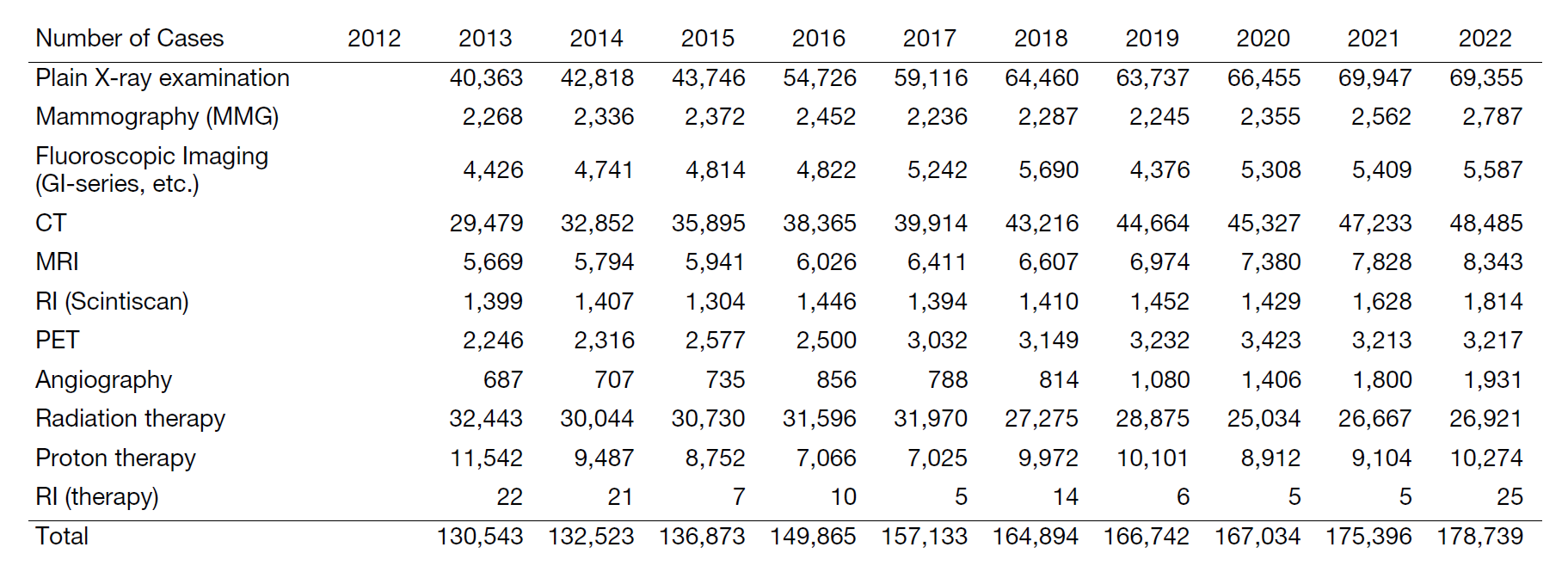Annual Report 2022
Department of Radiological Technology
Masashi Itou, Masufumi Shinozaki, Yoshihisa Muramatsu, Junpei Shigenaga, Yuichi Nagai, Akira Inagaki, Moeka Mizuguchi, Kento Yokota, Kazusa Honda, Kanta Inoue, Kazuyuki Wakamatsu, Atsuko Takada, Naotaka Yamazawa, Toshiyuki Shibuya, Shun Aoyagi, Hiroyuki Ota, Chikara Mano, Yumika Hirai, Shuhei Ohashi, Takara Watanabe, Taknori Matsuoka, Kosei Hamagashira, Haruki Togo, Amon Ohsawa, Nariko Kakihana, Saeko Mochinaga, Syun Ohmori, Manami Satou, Manami Inohara, Tetsuya Aoyama, Yuuki Miura, Risa Ohno, Yuta Suzuki, Shinichi Takahashi, Yuuki Mizunuma, Satoe Kito, Takaki Ariji, Yuki Tanaka, Kazuto Kano, Taku Tochinai, Hajime Ohyoshi, Toshiya Rachi, Kota Hirotaki, Takashi Someya, Naoki Yamashita, Nene Hashizume, Ken Hirayama, Yuya Fujimoto, Chiaki Tagami
Clinical/ Research Activities
Our total number of radiographic exams/radiotherapies increased by 102% compared to the previous year (see Table 1). The number of interventional radiology exams and radiotherapies, particularly intensity-modulated radiation therapy and stereotactic body radiation therapy, increased significantly with the expansion of indications. In addition, a new approach to treating neuroendocrine tumors with the radiopharmaceutical lutetium oxodotreotide (Lu-177) is in progress, as well as a new clinical trial in the application of internal radioisotope (RI) therapy.
In research activities, our department entered into joint research agreements with six companies and continued to conduct bridging research on clinical technologies. The main areas of research include: next-generation CT systems, artificial intelligence (AI)-driven image quality assurance systems, facial recognition technology for enhanced patient authentication accuracy even with masks, dose management systems in RI exams and the potential benefits of immediate adaptive radiation therapy.
Table 1. Transitions in number of radiological examinations and radiation therapies by year.

Research Results
Regarding MRI imaging, we have studied the use of compressed sensing for imaging of lingual neurovascular bundle to shorten imaging time and improve image quality with less image quality degradation compared to conventional high-speed imaging methods. The results showed the reduction of the examination time without compromising the image quality.
In the RI field, the relationship was examined between the image quality index (NEC) of FDG-PET/CT examinations and patient parameters (weight, height, BMI, blood glucose level, etc.) and acquisition time. As a result, the NEC could be optimized by changing the imaging conditions to suit the individual patient information. Furthermore, we modified the examination workflow to ensure uniform RI uptake time, and obtained results that enabled us to provide stable PET/CT examination images.
In adaptive radiation therapy (ART) for head and neck cancer, an effort was made to predict the timing of ART in accordance with anatomical shape changes by machine learning based on irradiation factor (MU, irradiation field shape, etc.).
Human Resource Development and Education
Job rotations are conducted to maintain and improve functions of each department. In our department, six radiological technologists are performing their duties in their respective departments, including those seconded to the Clinical Coordinator Office, Medical Information Department, Ethics Review Office, Medical Affairs Management Section, and Japan Agency for Medical Research and Development (AMED)
A residency program for radiology technologists was started in April 2022, and the first- and second-grade staff members (1 and 2 for each) are currently taking courses according to the syllabus and curriculum. The purpose of this program is to train and produce highly specialized, knowledgeable, and skilled radiological technologists in order to equalize, develop, and expand cancer care and to protect the lives and health of the public. The program consists of two levels: a three-year basic course for oncology technologists (the general radiology training course at the Kashiwa Campus) and a two-year specialized training course for oncology technologists. In the 2024 residency recruitment, 51 people attended the information session and 12 people participated in the tour.
Outlook
As the workload continues to increase, and in view of the task shift, we aim to actively attend publicly announced training courses in the expansion of work groups, and acquire each field's certification.
List of papers published in 2022
Journal
1. Rachi T, Ariji T, Takahashi S. Development of Machine-Learning Prediction Programs for Delivering Adaptive Radiation Therapy With Tumor Geometry and Body Shape Changes in Head and Neck Volumetric Modulated Arc Therapy. Advances in radiation oncology, 8:101172, 2023
2. Fujii K, Nomura K, Imai K, Muramatsu Y, Tsushima S, Ota H. Evaluation of Apparent Noise on CT Images Using Moving Average Filters. Journal of digital imaging, 35:77-85, 2022
3. Hirotaki K, Moriya S, Tachibana H, Sakae T. Detection of anatomical changes using two-dimensional x-ray images for head and neck adaptive radiotherapy. Medical physics, 49:3288-3297, 2022
4. Rachi T, Parshuram RV, Tanaka Y, Togo H. Examination of conversion method of dose distribution of lung cancer IMRT using fluence reversible calculation function in O-ring type linac and C-type linac. Physical and engineering sciences in medicine, 45:559-567, 2022
5. Fujii K, Nomura K, Muramatsu Y, Ota H. PATIENT-SPECIFIC ORGAN DOSE EVALUATION BASED ON MONTE CARLO SIMULATION AND DOSE METRICS IN PAEDIATRIC CHEST-ABDOMEN-PELVIS CT EXAMINATIONS. Radiation protection dosimetry, 197:46-53, 2021
